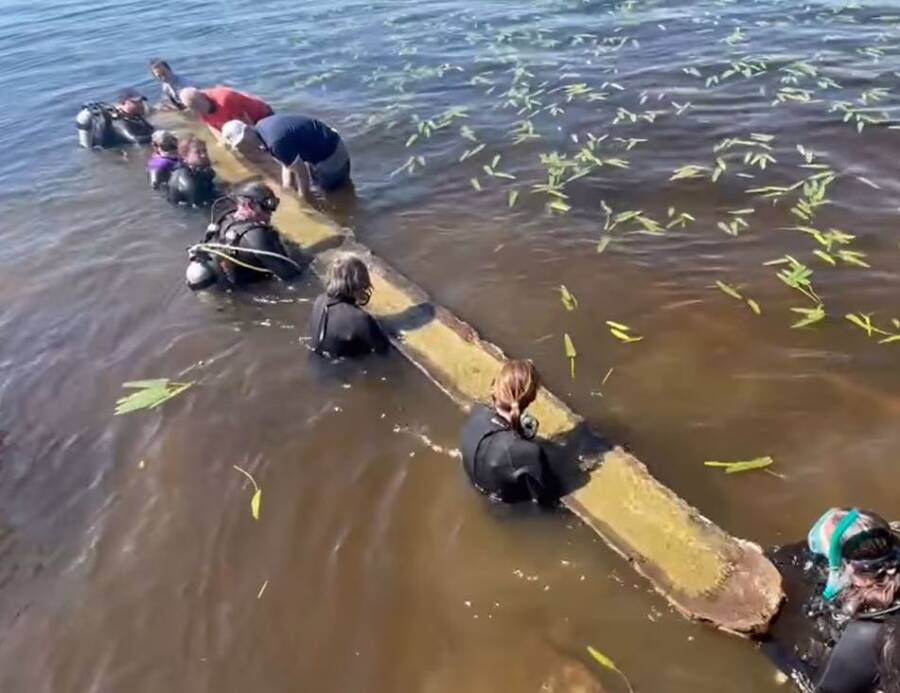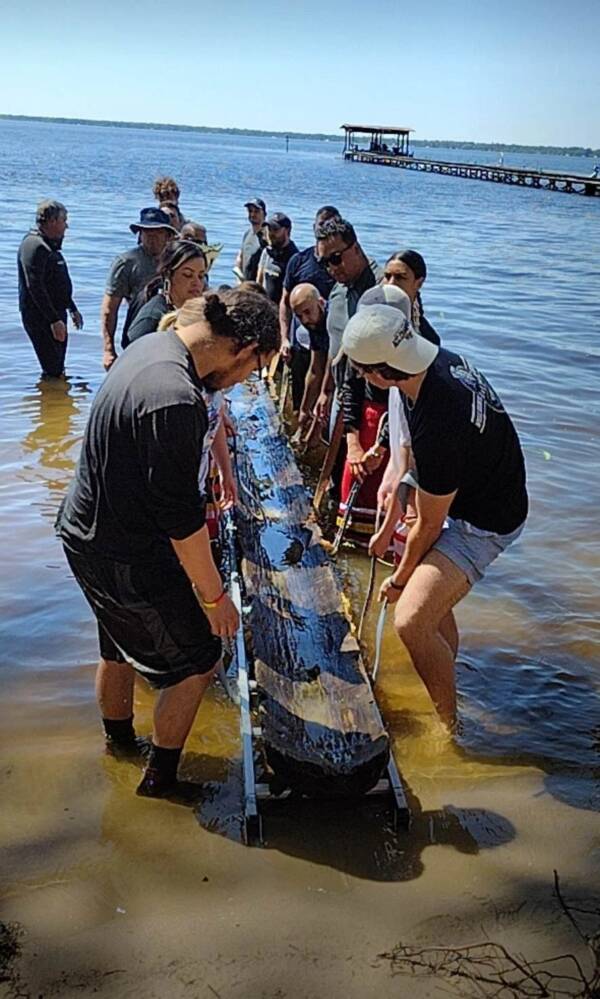This 28-foot boat sat just five five beneath the surface of Lake Waccamaw for nearly a millennium before three local teens uncovered it by accident while going for a swim.

North Carolina American Indian Heritage CommissionThe North Carolina Office of State Archaeology and the Waccamaw Siouan Tribe oversaw the removal of the ancient indigenous canoe.
Two years ago, a teenage boy swimming in North Carolina’s Lake Waccamaw stumbled upon what appeared to be a log wedged in the muck. However, this “log” was actually an ancient Indigenous canoe — and it’s just been removed from the water for the first time in almost 1,000 years.
“This is history in the making,” said Waccamaw Siouan Chief Michael Jacobs in a Facebook Live post from Columbus County News as members of the North Carolina Office of State Archaeology and the Waccamaw Siouan Tribe retrieved the canoe from the lake.
Jacobs added that this find provides unique insight into the history of his people, saying, “That canoe at 28 feet long would have carried many a brave. We feel like in our heart, it’s a history that we’re still exploring and understanding because this is the first time we’ve had access.”
This stunning piece of ancient Indigenous history had long been hidden on the bottom of Lake Waccamaw. But in the summer of 2021, boys swimming in the lake came across it by accident.
“We were throwing mussels at each other and I stepped on it and I thought it was a log,” Eli Hill told ABC 11. “I tried to pick it open and never came up. So, we kept digging at it and it just kept going. And then the next day, we came back and we started digging some more and it just kept going.”
Hill’s family reached out to the North Carolina Office of State Archaeology, who examined the canoe and decided to remove it from the muck.

North Carolina American Indian Heritage CommissionRemoving the canoe was a lengthy process, state archaeologists said, but well worth the effort.
“This canoe is about 1,000 years old,” State Archaeologist John Mintz explained to WBTV. “It’s a southeastern Indian canoe that originated from this area.”
Removing the canoe from the lakebed was a long process, Mintz explained, but its historical value made it worth it — especially for the Waccamaw.
On the day of the canoe’s removal from Lake Waccamaw, tribe members, leaders, and their children lined the lakeshore to watch. As the canoe emerged, they waded into the water and touched the ancient artifact, prayed over it, and sang Indigenous songs.
“Our history is still unfolding,” Jacobs explained. “When colonists made contact with our tribe, there’s a lot of things that we held as historical and as meaningful to us, as cultural, that we’re still putting together.”

Columbus County NewsTribal members touched the canoe, and both prayed and sang over it once it was removed from the lake.
Safely removed from the lake, the 930-year-old Indigenous canoe will next go to a lab in Greenville for examination and preservation. And Jacobs is hopeful that the artifact will reveal its secrets.
“We’re looking forward to examining it, running some tests on it, really finding out and going back to our elders and getting the history of it to where we can teach the truth to our people and know that we’ve got concrete evidence to stand on,” he explained to ABC 11.
From there, the canoe will be returned to the Waccamaw Siouan tribe. Columbus County News reports that it will be transported to tribal grounds in Buckhead, where it will make its permanent home. The canoe is the first such artifact to be housed there, and the tribe is hopeful that there will be more to come.
As for Hill, the teenager who first discovered the canoe? He told local news that he is grateful that he was able to play a role in the artifact’s discovery and help return it to its rightful owners.
“I realize that it means more to them than it does to me,” Hill noted. “So, I just thought it was a really cool experience for all of them just to be a part of that.”
After reading about the ancient Indigenous canoe discovered in a North Carolina lake, see how 8,000-year-old Indigenous artifacts were discovered in an alligator’s stomach in Mississippi. Or, look through these stunning Native American photographs taken by Edward Curtis.





